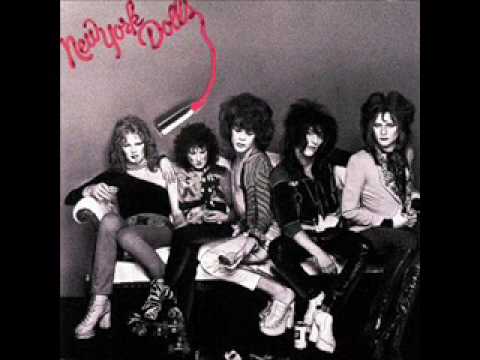Featured Song: Personality Crisis by The New York Dolls (August, 1973/Mercury Records/New York, NY)
Among the biggest misconceptions about punk rock is one we sort of have to perpetuate in the act of discussing the history. That misconception is that any of the early acts were at all popular in their time. With the exception of David Bowie and maybe The Kingsmen during the height of Louie Lou-eye, none of the acts I've mentioned so far would have been known to the average person back then. Though much ink was spilled over these groups, none of it translated particularly well into album or ticket sales. Indeed, most of the acts I've written about only really start to gain wider appeal in the 80s, but we'll get back to that later. For now, though, when I say a particular band was really successful, it comes with the caveat 'for what they were.' What these bands were, was weirdos making music to be enjoyed by other weirdos. In that regard, they were all a big success. They brought the weirdos together to celebrate weirdness and encouraged weirdos to seek out other weirdos with whom to rebel against The Conspiracy Of Normalcy. However, as a bunch of weirdos in an upstart band, venues that will host your music are hard to find. In New York City, the most important venue to weirdos was at 240 Mercer Street.
The Grand Central Hotel was built at 673 Broadway, the site of the old LaFarge Hotel, which burned down in 1867. At the time of The Grand Central Hotel's opening in 1870, it was the largest hotel in North America, and among the many amenities was a complex of live theaters. By the time of the Grand Central Hotel's centenary, it had become a welfare hotel. The place was a rat-infested dump, and in 1970, club promoter Art D’Lugoff bought the first two floors on the Mercer Street side of the building, which housed the theater complex, and transformed it into The Mercer Arts Center. The main floor was home to two theaters, the Mercer Hansberry and the Mercer Brecht. The second floor featured four cabaret theaters and a rehearsal space. As one could expect from a theater complex with sections named for Brecht and Hansberry, it was the home of some really avant-garde theater productions and performative art pieces by a growing movement in New York City called Theater Of The Ridiculous. Among the major figures of Theater of The Ridiculous in this time is a guy called John Vaccaro. By all accounts, Vaccaro was a shitty guy, but he did make a big impact when he came across some wholesale glitter in Chinatown while shopping for costume material.
Vaccaro had been using glitter in his productions since the mid 50's, but it really caught on with his Theater Of The Ridiculous cohorts. To him, glitter represented the gaudiness of America. It was shiny and pretty, but also cheap and ultimately kind of annoying. He encouraged his troupe to use it in as many ways as possible. As such the cast was usually covered in glitter, and their outrageous productions lent to a correlation between glitter and outrageous behavior. Needless to say, when London glam came to New York City, this is where it caught on. However, as I said in the last installment, glam didn't really catch on in America like it did in Br*tain, at least not at first. Glam caught on in America thanks to a toned-back version they called Glitter Rock. However, among the first American acts to really get into the whole Glam thing was The New York Dolls.
The Dolls came together in 1971,named after The New York Doll Hospital, a vintage doll repair shop across the street from the men's store guitarist Sylvain Sylvain worked at. Sylvain, along with David Johansen, Johnny Thunders, Sylvain Sylvain, Billy Murcia, and Arthur "Killer" Kane played their first live gig on Christmas Eve, 1971. Employees of the Endicott Hotel, a housing co-op across the street from The Dolls' rehearsal space, heard them rehearsing and invited them to come play later that night. According to legend, they all arrived intoxicated, wearing spandex, fishnets, and lipstick, and professed they were all gay.
The New York Dolls became a big hit in the Mercer Arts Center, landing a regular Tuesday-night gig in the kitchen at the Mercer Arts Center. Eventually, they were joined by actress/singer Ruby Lynn Reyner and her band Ruby and The Rednecks . In 1972, the owners decided they didn't want rock acts in their venue and kicked out The New York Dolls. However, when they saw the dent it took out of the bar's revenue, they swiftly came crawling back. Soon after, they expanded the roster of regular acts to include The Modern Lovers and Suicide, the latter being one of the first acts to promote themselves as "Punk music." The Mercer Arts Center, or more specifically the actual kitchen inside the Mercer Arts Center, had become a sort of home for weirdos in New York who couldn't get into a more high-status place like Max's Kansas City.
However, in 1973, a problem emerged: The walls began to sag. The theater had plastered over the sagging walls over and over, but to no avail. At 2:30 PM on August 3rd, 1973, the center's owner Gene Frankel heard the cracked walls in his workshop begin groaning. Shortly after, the bricks started falling, and the Mercer Arts Center was evacuated. Just after 5:10 PM, there was a loud crack, and the 8-story Grand Central Hotel collapsed onto Broadway. Herbert Whitehead, Kay Parker, and Arthur and Peggy Sherwin died as a result of the collapse. The next day, mayor John Lindsay ordered all pre-1901 buildings to be evaluated for structural safety. Investigators found that the trouble at Grand Central Hotel was caused by a 1969 basement renovation that removed a load-bearing wall. This, combined with aggravation from a nearby subway line, caused the collapse. A legal battle ensued, with victims suing the hotel owners, the hotel owners suing the theater owners, and the theater owners suing the city of New York. A 1980 ruling deemed the city liable for 30% of the damages, but that ruling was overturned on appeal in 1983. The collapse of the Mercer Arts Center was devastating for the upstart bands who called The Kitchen home. For the rest of the year, they would have to convince promoters and bar owners to let them play their weird music for weird people.
Next time: The Weirdos Move To The Worst Bar In New York


